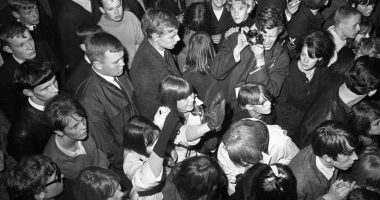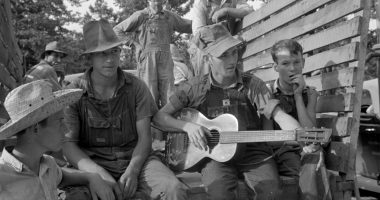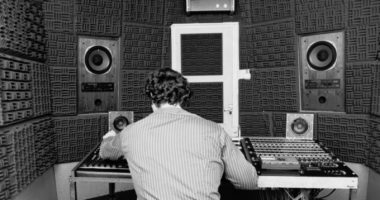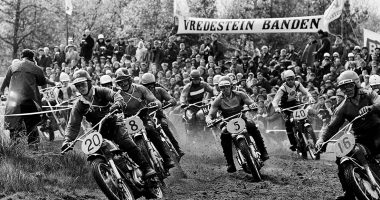
A flight deck crew member attempts to communicate with a companion despite the plane engine noise aboard the aircraft carrier USS JOHN F. KENNEDY (CV-67) | The US National Archives | Public domain
As audio media such as podcasts and audiobooks surge in popularity, we propose three alternatives to the consumption of audio content that deliberately subvert the act of listening – the atmospheres of ambient music, the world of field recordings, and the exploration of silence. In an ever faster, noisier and more complex society, it is worth the effort to pause and explore other ways of paying attention. Ways of relating to the world that don’t have to pass through the filters of the big platforms and the fight for content optimisation.
A man sits astride a galloping horse. Somebody sees him and shouts out “Where are you going?”. And the rider, turning round, replies “I don’t know, ask the horse!”. Just like in this Zen story, the hyperconnected world seems to move forward without really knowing where it’s going. But this is nothing new. For more than two centuries, capitalism has been shortening time and constricting space, making it ever more quickly accessible. In the area of cultural production, the digital revolution has generated an immeasurable offering of contents that, thanks to a business model based on advertising, has resulted in the so-called ‘attention economy’. In other words, in an understanding of people’s attention as a scarce resource that companies must compete for by tracking their behaviour and tastes.
In her talk How to do nothing. Resisting the attention economy, the American artist Jenny Odell draws parallels between what capitalism does to the environment and what the digital economy does to our ability to become interested in something: “In both cases, there’s a tendency toward an aggressive monoculture, where those components that are seen as ‘not useful’ and which cannot be appropriated (by loggers or by Facebook) are the first to go”.
This article proposes three ways of relating to the attention economy in a specific sphere, that of audio, which has become the new battlefield to be taken over by this fight. Podcasts, audio fiction, audiobooks… they all populate periods of time that were once dedicated to public transport, sport, walks, household chores… Periods, those of everyday life, that had largely been excluded from the consumption of images, and which are now being invaded, or at least accompanied by, the consumption of sounds. The three practices described below consist of not listening in the metaphorical sense, as they in fact consist of a different way of listening, and constitute three proposals for investigating and learning to use our ears for fun.
1. Background music
The fight for our attention is nothing new in the music industry. Alizzz, one of the producers of the moment, defines it like this in a recent interview: “Something needs to be happening all the time. Technology has messed with our heads and we’re incapable of paying attention unless we have constant inputs. Nowadays its harder to make a long single”. Most record labels have based their strategy on this premise, although the minority genres normally have some room to experiment. This is the case of music classed as ‘ambient’, a vaguely defined genre that groups together different types of atmospheric music. These are repetitive electronic compositions, with a long length and no defined rhythm, that tend to be evocative. “Often, the records make you feel as though you’re in two places at once”, wrote Joshua Rothman, editor of The New Yorker, “it gives you the sense that there might be an alternate way of inhabiting the place and time where you are located”.
The innovative Erik Satie is often named as the forefather of the genre. In the early 20th century, he invented the concept of “furniture music”, which he composed by way of a satirical experiment and which was designed as non-invasive background music for parties and events. However, the emergence of ambient music as such is attributed to Brian Eno, who coined the term in his 1978 record Ambient 1: Music for Airports. In the album sleeve notes, the artist defines it as music “intended to induce calm and a space to think”, highlighting that “it must be able to accommodate many levels of listening attention without enforcing one in particular; it must be as ignorable as it is interesting“.
In the last forty years, the genre has undergone a fertile and diverse evolution, although beyond its musical appeal, it is remarkable that a type of art should invite us to reflect more on how it is received than how it is created, and to decide what degree of attention we wish to pay to the work. Most art and culture, especially in the attention economy, explicitly sets out to attract our curiosity, which is why it’s worthwhile giving this genre a chance, even if only to experiment with the act of listening itself.
2. Noise
Anyone with an interest in ambient music will realise straight away that the ideal volume for listening to it is neither too loud nor too quiet. Just high enough to create an atmosphere, while leaving enough room for the noises created by the surroundings. In fact, the environment is the raw material for the second listening practice that requires a different kind of attention. This practice is field recording, i.e. recording the sounds of nature or different environments in a non-studio setting.
Field recording has its roots in documentaries, although it soon branched out into disciplines such as bioacoustics and acoustic ecology, which use sound recordings to study the behaviour of animal species and the health of natural habitats. In fact, thanks to artificial intelligence and big data, these fields of study continue to evolve. A couple of good examples are projects such as Rainforest Connection, an organisation that uses used smartphones to listen out for illegal logging in rainforests across the world; and Pattern Radio: Whale Songs, which uses Google AI to analyse thousands of hours of whale songs.
These environmental disciplines soon gave rise to initiatives halfway between the conservation and the poetic evocation of the environment, resulting in recordings that can be appreciated on the emotional level. This is the case of soundscapes – ambient sound recordings of specific contexts which also include those generated by humans. This field was pioneered mainly by the influential composer and educator R. Murray Schafer, who considers the world to be “a macrocosmic musical composition” and that his role as a sound artist is to remind people that “if you listen carefully, your life is enhanced”.
Along the same lines, and beyond recording as a form of documentation, there is “deep listening”, proposed in the 1970s by Pauline Oliveros. The artist and writer defines it as the act of “listening in every possible way to everything possible to hear no matter what you are doing. Such intense listening includes the sounds of daily life, of nature, of one’s own thoughts as well as musical sounds”. A practice which she applied in the form of meditation exercises designed to develop receptivity and override the tendency for constant analysis and judgement that she considered to dominate western culture.
It is worth remembering that this type of listening, somewhere between historical recording and contemplation, was one of the common experiences of the 2020 COVID lockdowns. Certain initiatives have documented this renewed interest in sound in the form of projects such as ‘Historias Sonoras del COVID19‘ (Sound stories of COVID19) and the audio essay ‘Silencio de radio‘ (Radio Silence) by Isabel Cadenas Cañón.
3. Silence
The appreciation of noise is intimately related to the third and last proposal in the area of auditive attention – trying not to listen to anything. An invitation that is in itself paradoxical, as if silence is the absence of sound, what is it that can be appreciated when you hear nothing?
When writing about the exploration of silence, mention must be made of the experimental musician John Cage, who during the 20th century dealt with this subject in several of his compositions. In his collection of essays Silence, he tells how his research took him to the anechoic chamber at Harvard, a room designed to absorb acoustic and electromagnetic waves, making it possibly the best place in the world for hearing absolutely nothing: “I heard two sounds, one high and one low. When I described them to the engineer in charge, he informed me that the high one was my nervous system in operation, the low one my blood in circulation. Until I die there will be sounds”.
His realisation of the impossibility of absolute silence was what spurred the creation of the ineffable 4’33”, composed in 1952 with the instruction that the musician should hold or sit in front of their instrument without playing it for the four minutes and thirty-three seconds announced in the title. In his book Ocean of Sound, the musician and writer David Toop notes in reference to 4’33” that there is a “mistaken assumption that this was a Zen demonstration of nothingness”, although in fact, given that Cage had already confirmed that absolute silence does not exist, the point of the piece was to create a “growing awareness of the immediate sound environment”. An environment that could be the concert hall (with muffled sounds from outside, the hum of the air conditioning, the cough of a concertgoer), or even the home. In fact, Toop himself describes his experience of playing a 1974 recording of the piece: “For the first time, I listened to the surface noise of a bad vinyl pressing from Italy with interest rather than irritation”.
However imperfect it might be, the appreciation of this relative silence fulfils another purpose beyond the aesthetic – to offer a certain degree of peace and calm as a remedy to the uproar of the modern world. Something that Cage also dealt with in his unstarted project Silent Prayer, which was to consist of an uninterrupted recording of silence, which he would then try to sell to Muzak Co., the company that made its name from inventing background music. Apart from the idea’s obvious sarcasm, the American musician envisaged it as a possible way to quieten the din of consumer society with a peacefulness that would flow into offices, shopping centres, cafés, doctor’s surgeries, lifts…
A herald
It is fair to acknowledge that both the appreciation of silence and some of the previously mentioned experiments may be afflicted by a certain privileged western-centric perspective.
This said, a number of trends that run along these lines can be seen to be converging in mainstream culture across the world – meditation, forest bathing, spiritual retreats and other practices halfway between wellness and mental health, for example, but also the search for less crowded urban living and a new appreciation of life outside the big cities, especially in the context of the pandemic.
Jacques Attali wrote in 1985 that “music is neither an autonomous activity nor an automatic indicator of the economic infrastructure. It is a herald, for change is inscribed in noise faster than it transforms society.” If he was right, that which can be heard and which is listened to is a reflection of social changes, although it may also be their cause. Not in vain, the album of whale songs Songs of the Humpback Whale helped to save this species after it unexpectedly became a global hit. Although on a less ambitious scale, ambient music, field recordings and the exploration of silence serve as exercises for investigating, understanding and even relating in a new way to the constant noise of urban chaos and digital overload.





Leave a comment